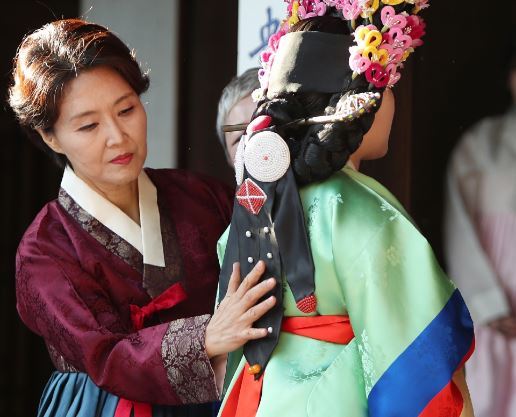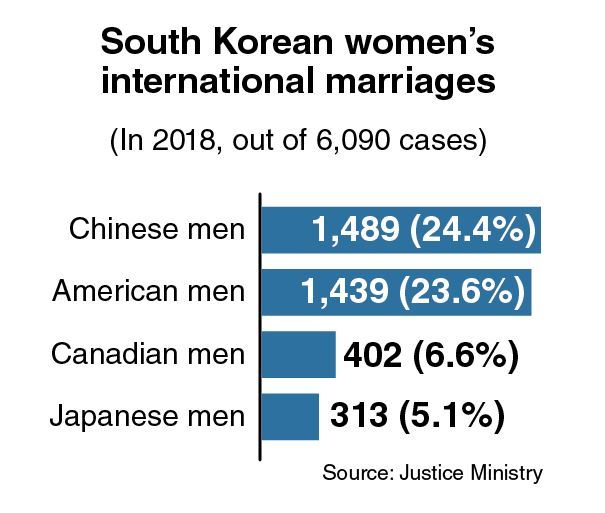[News Focus] International marriages increasing after lull in 2010s
Nearly half of Korean women who married foreigners in 2018 chose Chinese or American grooms
By Kim Yon-sePublished : Jan. 21, 2020 - 13:42

SEJONG -- International marriages to South Koreans recorded a continuous decline in the 2010s, despite the growing number of foreign nationals residing here.
In 2010, 34,235 Koreans -- 26,274 men and 7,961 women -- married foreigners. But the latest official figure, for 2018, was down 33.6 percent from eight years earlier, according to the Ministry of Justice, to 22,698 -- 16,608 men and 6,090 women.
For Korean men who wedded foreign women in 2018, Vietnamese brides were the most numerous at 6,338. Next on the list were Chinese at 3,671 and Thais at 1,560. Among the other foreign women who married Korean men in 2018 were 987 Japanese, 852 Filipinas and 567 US nationals.
The number of marriages between Korean men and Chinese women dropped drastically, from 9,623 in 2010. In contrast, marriages between Korean men and Thai women were much more commonplace, having recorded just 438 eight years earlier.
For Korean women who married foreign nationals, marriages to Chinese and Americans were the most common, whereas marriages to Japanese men fell off sharply over the corresponding eight years.
In 2018, 1,489 Korean women married Chinese men and 1,439 married Americans. Collectively, the two nationalities accounted for nearly 50 percent of the 6,090 foreign men who married Korean women that year. The number of marriages between Korean women and Japanese men fell from 2,090 in 2010 to 313 in 2018, sliding below 1,000 in 2015.
Other major nationalities for the spouses of Korean brides in 2018 were Canadian (402 men) and Australian (189 men).
“The number of international marriages continued to fall between 2010 and 2016. But the figure is estimated to be in a modest recovery mode after touching the bottom three years ago,” said a government official.
On the contrary, the nation saw the number of foreign residents grow rapidly in the 2010s, according to the Justice Ministry data.
A decade ago, the number of foreigners residing in Korea posted 1.16 million. Those included immigrants staying long-term as well as short-term migrants, including workers and students.
Since then the figure had increased by about 100,000 per annum to 2.45 million as of September 2019, up 111 percent compared with December 2009. The number of foreigners residing in Korea topped 1.5 million in 2013 and 2 million in 2016.

Foreigners in their 30s were the most numerous at 640,000 as of September 2019, comprising 26.4 percent of the total. Next were those in their 20s at 610,000 (25 percent), those in their 40s at 390,000 (16.1 percent) and those in their 50s at 340,000 (14.2 percent).
While there were 270,000 foreign nationals aged 60 or over (11.1 percent), those aged 19 or under numbered only 160,000 (6.9 percent).
The ministry’s annual data showed that Americans had slid to No. 4 on the list of nationalities making up the greatest percentage of foreigners in Korea. Previously, as of 2015, US nationals held the No. 2 rank at 138,000 -- only Chinese were more numerous, at 955,000. But in 2016 and 2017, Thais and Vietnamese overtook those from the US in proportion to Korea’s overall foreign population.
As of 2018, Chinese maintained the No. 1 position with 1.07 million nationals living here, trailed by Thais with 197,000, Vietnamese with 196,000 and Americans with 151,000. Next were Uzbeks with 68,000 and Japanese with 60,800.
Furthermore, the number of foreigners studying in Korea saw a steeper growth curve.
The number of foreign students in Korea, which stood at 86,400 at the end of 2014, increased to 96,300 in 2015, 115,900 in 2016, 135,000 in 2017 and 160,600 in 2018.
Among the 160,600 students, Chinese (including Korean-Chinese) made up the largest proportion with 68,900, followed by Vietnamese with 45,100, Mongolians with 8,600 and Uzbeks with 7,800.
Among English-speaking countries, the US accounted for the greatest number of foreign students with 1,210, followed by the UK with 241, Canada with 152, Australia with 108 and New Zealand with 17.
Among Japanese students in Korea (2,676), women far outnumbered men at 2,291 to 385. Of the 702 students from Hong Kong, there were 589 women and 113 men.
Of the 160,600 foreign students in Korea, 52,000 were working toward bachelor’s degrees, with 23,000 aiming for master’s degrees and 9,700 for doctorates.
By Kim Yon-se (kys@heraldcorp.com)



![[Exclusive] Korean military set to ban iPhones over 'security' concerns](http://res.heraldm.com/phpwas/restmb_idxmake.php?idx=644&simg=/content/image/2024/04/23/20240423050599_0.jpg&u=20240423183955)




![[Herald Interview] 'Amid aging population, Korea to invite more young professionals from overseas'](http://res.heraldm.com/phpwas/restmb_idxmake.php?idx=644&simg=/content/image/2024/04/24/20240424050844_0.jpg&u=20240424200058)
![[Pressure points] Leggings in public: Fashion statement or social faux pas?](http://res.heraldm.com/phpwas/restmb_idxmake.php?idx=644&simg=/content/image/2024/04/23/20240423050669_0.jpg&u=)









